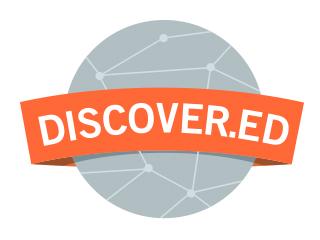Andy Sigler
Sergio Majluf
Su Hyun Kim
Yuliya Parshina
discoverED
DiscoverED is a set of digital tools that allows independent learners and educators to build and traverse knowledge paths by linking the most helpful online resources in an interactive, intuitive, and easy to use visual interface that mimics neural networks.
http://itp.nyu.edu/~sam926/static/discovered/step01.html

Classes
Hacking Higher Ed
Hacking Higher Ed
DiscoverED provides a better and deeper teaching and learning experience, by allowing users to visualize their own learning paths and discover new, related knowledge.
"Lessons" and steps within these lessons are posed as questions to better mimic the way a human mind seeks out knowledge.Users con ask and answer their own questions, and also browser and answer questions already posted on the web application.Finally, learning paths visualised, can be shared with other people.
Background
We looked a lot at online communities and aggregators that encourage self-initiated, peer-reviewed learning. These sites include Stackoverflow, How Stuff Works, wikiHow, and Instructables.
Unlike the competitors, our product gives users the ability to connect, or cross-reference, helpful answers from various sources, and craft a brand-new learning thread.
. In that sense, we might be also stepping into Google's territory, where they provide excellent, accurate search results to granular, specific question, and display them in linear, non relatable fashion. DiscoverED aims to help people turn that content into knowledge, by providing relationships, context and a spatial interface affordances to create a better learning experience for the educator and the user.
Audience
While in the long run, all learning would use discoverED for self-directed learning, the initial users will be educators and those looking to document their work in a modular fashion. Internet users who write and record tutorials and instructions on their areas of expertise could make their content more accessible through our system.
User Scenario
An educator interested in creating a tutorial or syllabus using our tool will type in the question in the "ask" bar.
If similar questions exist, they will be given a choice to review them, or proceed to adding their own.
In the "add your own" interface, the educator will break down instructions into sequential steps. The completed "question/answer" lesson is visualized as a network of connected nodes. Each node in the network shows connections to other, related nodes, outside the current lesson.
The user can explore the related nodes and add them to their current network. Other users can explore existing networks and add better node options.
Implementation
The application would have a backend layer running Sinatra and MongoDB as a database, deployed over Heroku cloud services.
The frontend would be coded using HTML + CSS + JS, and the demo is currently working off of Twitter Bootstrap framework, resorting to JavaScript D3 library to provide the network representation and interaction layer.
Conclusion
Through this experience we explored a lot of UX issues and thought a lot about alternate ways of learning.
"Lessons" and steps within these lessons are posed as questions to better mimic the way a human mind seeks out knowledge.Users con ask and answer their own questions, and also browser and answer questions already posted on the web application.Finally, learning paths visualised, can be shared with other people.
Background
We looked a lot at online communities and aggregators that encourage self-initiated, peer-reviewed learning. These sites include Stackoverflow, How Stuff Works, wikiHow, and Instructables.
Unlike the competitors, our product gives users the ability to connect, or cross-reference, helpful answers from various sources, and craft a brand-new learning thread.
. In that sense, we might be also stepping into Google's territory, where they provide excellent, accurate search results to granular, specific question, and display them in linear, non relatable fashion. DiscoverED aims to help people turn that content into knowledge, by providing relationships, context and a spatial interface affordances to create a better learning experience for the educator and the user.
Audience
While in the long run, all learning would use discoverED for self-directed learning, the initial users will be educators and those looking to document their work in a modular fashion. Internet users who write and record tutorials and instructions on their areas of expertise could make their content more accessible through our system.
User Scenario
An educator interested in creating a tutorial or syllabus using our tool will type in the question in the "ask" bar.
If similar questions exist, they will be given a choice to review them, or proceed to adding their own.
In the "add your own" interface, the educator will break down instructions into sequential steps. The completed "question/answer" lesson is visualized as a network of connected nodes. Each node in the network shows connections to other, related nodes, outside the current lesson.
The user can explore the related nodes and add them to their current network. Other users can explore existing networks and add better node options.
Implementation
The application would have a backend layer running Sinatra and MongoDB as a database, deployed over Heroku cloud services.
The frontend would be coded using HTML + CSS + JS, and the demo is currently working off of Twitter Bootstrap framework, resorting to JavaScript D3 library to provide the network representation and interaction layer.
Conclusion
Through this experience we explored a lot of UX issues and thought a lot about alternate ways of learning.

